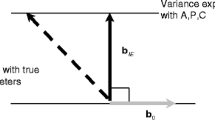Abstract
A class of estimable contrasts is defined for cohort effects in an age-period-cohort model. It is useful for detecting a systematic change in cohort effects without suffering from a short term deviation. This together with the follow-up analysis of residuals will give a good insight into the data. Numerical examples are given to illustrate how the method applies.
Similar content being viewed by others
References
Fienberg S. E. and Mason W. M. (1979). Identification and estimation of age-period-cohort models in the analysis of discrete archival data, Sociological Methodology, (ed. K. F. Schussler), 1–67, Jossey-Bass, San Francisco.
Fienberg S. E. and Mason W. M. (1985). Specification and implementation of age, period and cohort models, Cohort Analysis in Social Research, (eds. W. M. Mason and S. E. Fienberg), 45–88, Springer-Verlag, New York.
Frost W. H. (1939). The age selection of mortality from tuberculosis in successive decade, Amer. J. Hygiene A, 30, 91–96.
Heckman J. and Robb R. (1985). Using longitudinal data to estimating age, period and cohort effects in earnings equations, Cohort Analysis in Social Research, (eds. W. M. Mason and S. E. Fienberg), 137–150, Springer-Verlag, New York.
Hirotsu C. (1982). Use of cumulative efficient scores for testing ordered alternatives in discrete models, Biometrika, 69, 567–577.
Hirotsu C. (1983). An approach to defining the pattern of interaction effects in a two-way layout, Ann. Inst. Statist. Math., 35, 77–90.
Hirotsu C. (1986). Cumulative chi-squared statistic as a tool for testing goodness of fit, Biometrika, 73, 165–173.
Holford T. R. (1983). The estimation of age, period and cohort effects for vital rates, Biometrics, 39, 311–324.
Johnson D. E. and Graybill F. A. (1972). An analysis of a two-way model with interaction and no replication, J. Amer. Statist. Assoc., 67, 862–868.
Tango T. (1985). Estimation of age, period and cohort effects—Decomposition into linear trend and curvature component—, Japan J. Appl. Statist., 14, 45–59 (in Japanese).
Author information
Authors and Affiliations
About this article
Cite this article
Hirotsu, C. A class of estimable contrasts in an age-period-cohort model. Ann Inst Stat Math 40, 451–465 (1988). https://doi.org/10.1007/BF00053058
Received:
Revised:
Published:
Issue Date:
DOI: https://doi.org/10.1007/BF00053058




